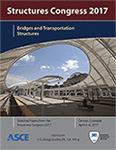Chapter
Apr 4, 2017
Unbonded Tendons as an Alternative for Bonded Tendons in Post-Tensioned Bridges: Constructability, Structural Performance, and Monitoring
Authors: A. B. M. Abdullah [email protected], Jennifer A. Rice [email protected], Rahul Bhatia [email protected], Natassia R. Brenkus [email protected], and H. R. Hamilton [email protected]Author Affiliations
Publication: Structures Congress 2017
Abstract
Bonded post-tensioning tendons are used extensively in segmental bridge construction and have generally provided satisfactory service with respect to durability. However, multiple tendon failures in U.S. bridges with grouted tendons have led to the exploration of other forms of corrosion protection. One potential option is to use flexible fillers inside the tendon duct instead of cement grout that do not bond the prestressing strands to the concrete section. The use of these unbonded tendons not only affects the ultimate strength, fatigue, and serviceability behavior of structural systems, but also encourages efficient monitoring methods and facilitates tendon replacement during the structure’s service life. The current bridge design code, however, does not explicitly address flexible fillers, and little guidance is given regarding unbonded tendons in general. To evaluate the structural performance of unbonded tendons, full-scale experiments were conducted with both external and internal I-girder specimens having deviated tendon profile. These investigations provide important information on structural behavior of unbonded systems as well as tendon constructability, and can assist in the preparation of material and construction specifications. Multiple laboratory experiments were conducted with commercially available flexible fillers to examine the constructability of unbonded tendons. These experiments focused on tendon and duct detailing, filler material preparation, injection process and equipment, and venting procedures. An analytical investigation was also performed to compute the rate of cooling of flexible fillers during injection, which is a critical parameter to ensure that flow clogging does not occur. In addition, a promising tendon monitoring algorithm has been developed that uses the strain variations in the wedge plates caused by load relief due to corrosion-induced wire breaks. Extensive analytical and experimental investigations demonstrate the method’s feasibility in detecting, locating, and quantifying tendon damage.
Get full access to this article
View all available purchase options and get full access to this chapter.
Information & Authors
Information
Published In
Copyright
© 2017 American Society of Civil Engineers.
History
Published online: Apr 4, 2017
Permissions
Request permissions for this article.
Authors
Affiliations
Postdoctoral Associate, Dept. of Civil and Coastal Engineering, Univ. of Florida, Gainesville, FL 32611. E-mail: [email protected]
Assistant Professor, Dept. of Civil and Coastal Engineering, Univ. of Florida, Gainesville, FL 32611. E-mail: [email protected]
Project Engineer, Baxi Engineering Inc., Houston, TX 77040. E-mail: [email protected]
Ph.D. Candidate, Dept. of Civil and Coastal Engineering, Univ. of Florida, Gainesville, FL 32611. E-mail: [email protected]
Professor, Dept. of Civil and Coastal Engineering, Univ. of Florida, Gainesville, FL 32611. E-mail: [email protected]
Metrics & Citations
Metrics
Citations
Download citation
If you have the appropriate software installed, you can download article citation data to the citation manager of your choice. Simply select your manager software from the list below and click Download.
View Options
Get Access
Access content
Please select your options to get access
Log in/Register
Log in via your institution (Shibboleth)
ASCE Members:
Please log in to see member pricing
Purchase
Save for later Item saved, go to cart Information on ASCE Library Cards
ASCE Library Cards let you download journal articles, proceedings papers, and available book chapters across the entire ASCE Library platform. ASCE Library Cards remain active for 24 months or until all downloads are used. Note: This content will be debited as one download at time of checkout.
Terms of Use: ASCE Library Cards are for individual, personal use only. Reselling, republishing, or forwarding the materials to libraries or reading rooms is prohibited.
Terms of Use: ASCE Library Cards are for individual, personal use only. Reselling, republishing, or forwarding the materials to libraries or reading rooms is prohibited.
Get Access
Access content
Please select your options to get access
Log in/Register
Log in via your institution (Shibboleth)
ASCE Members:
Please log in to see member pricing
Purchase
Save for later Item saved, go to cart Information on ASCE Library Cards
ASCE Library Cards let you download journal articles, proceedings papers, and available book chapters across the entire ASCE Library platform. ASCE Library Cards remain active for 24 months or until all downloads are used. Note: This content will be debited as one download at time of checkout.
Terms of Use: ASCE Library Cards are for individual, personal use only. Reselling, republishing, or forwarding the materials to libraries or reading rooms is prohibited.
Terms of Use: ASCE Library Cards are for individual, personal use only. Reselling, republishing, or forwarding the materials to libraries or reading rooms is prohibited.
